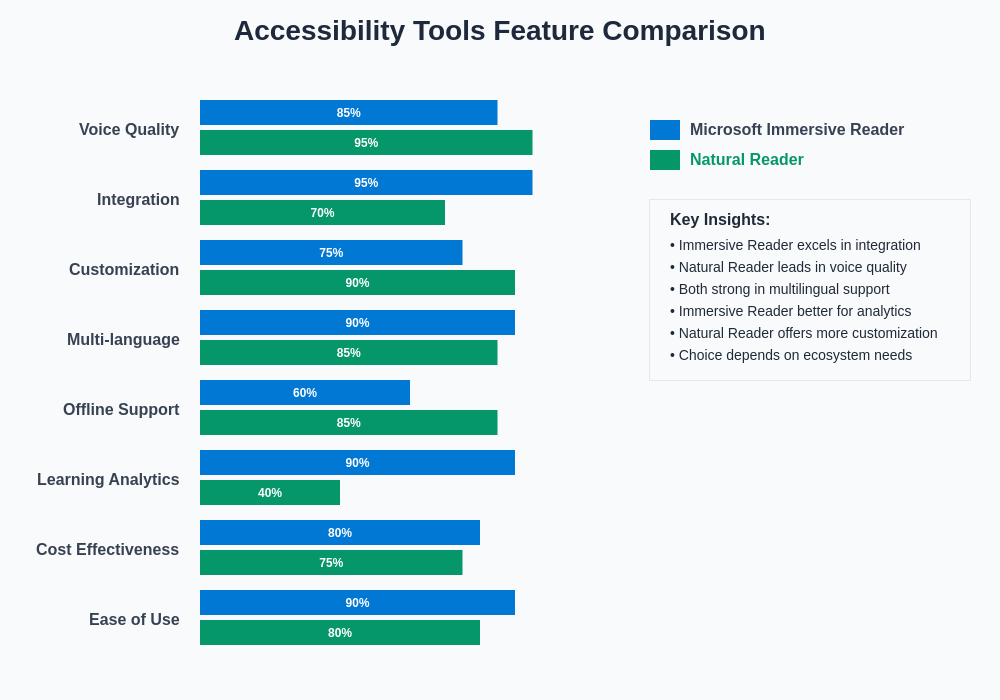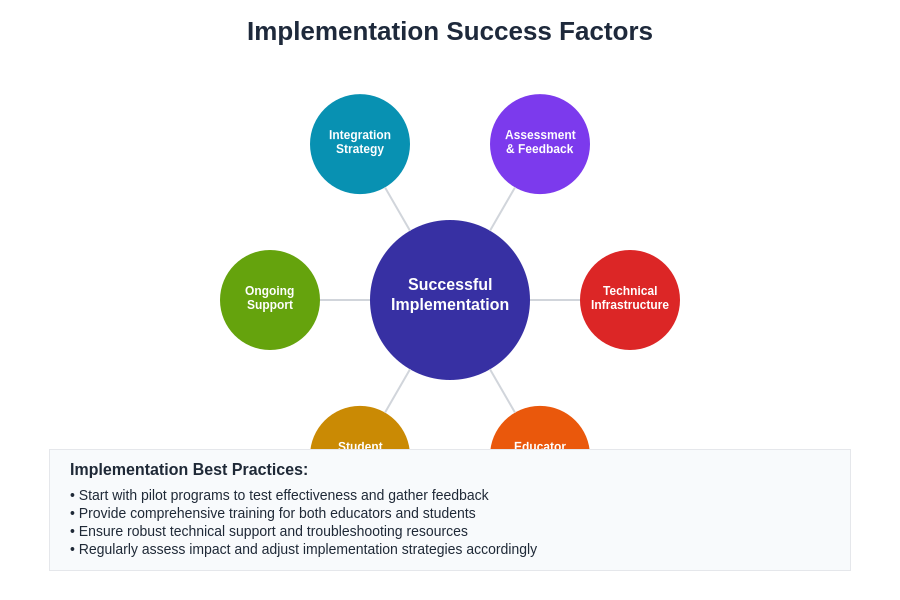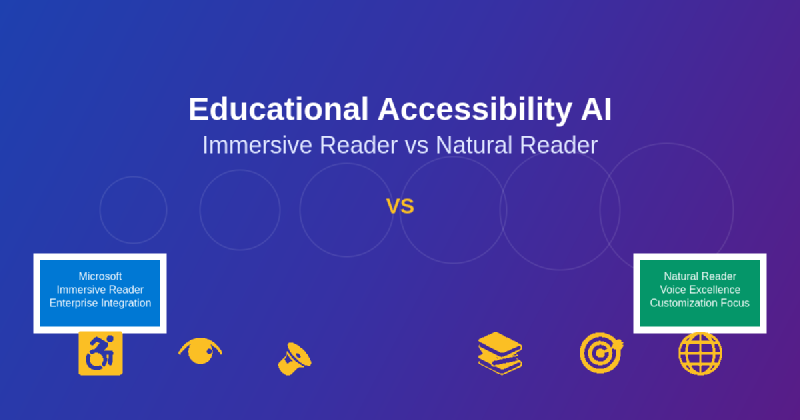The educational landscape has been profoundly transformed by artificial intelligence technologies designed to enhance accessibility and inclusivity for learners with diverse needs and learning differences. Among the most significant developments in this space are sophisticated text-to-speech and reading comprehension tools that leverage advanced AI algorithms to create more equitable learning environments. Two prominent solutions that have emerged as leaders in educational accessibility are Microsoft’s Immersive Reader and Natural Reader, each offering unique approaches to addressing the challenges faced by students with dyslexia, visual impairments, attention disorders, and other learning differences.
Discover the latest educational AI innovations that are revolutionizing how students access and interact with educational content across diverse learning environments. The evolution of accessibility technology represents a critical advancement in ensuring that educational opportunities remain available to all learners regardless of their individual challenges or learning preferences.
Understanding Educational Accessibility in the Digital Age
Educational accessibility has evolved far beyond traditional accommodations to embrace sophisticated AI-driven solutions that adapt to individual learning needs in real-time. The integration of artificial intelligence into accessibility tools has created unprecedented opportunities for personalized learning experiences that can automatically adjust content presentation, reading speed, visual formatting, and comprehension support based on each learner’s specific requirements and preferences.
Modern accessibility tools recognize that learning differences are not limitations but rather variations in how individuals process and interact with information. This paradigm shift has led to the development of comprehensive platforms that not only provide basic text-to-speech functionality but also incorporate advanced features such as syllable highlighting, grammar analysis, picture dictionaries, translation capabilities, and cognitive load management to create truly inclusive learning environments.
The impact of these technologies extends beyond students with diagnosed learning disabilities to benefit all learners who may struggle with traditional text-based content delivery. Research has consistently demonstrated that accessibility features designed for specific populations often enhance the learning experience for the broader student body, creating a universal design for learning that improves educational outcomes across diverse learner populations.
Microsoft Immersive Reader: Enterprise-Grade Accessibility
Microsoft Immersive Reader represents a comprehensive approach to educational accessibility that leverages the extensive Microsoft ecosystem to provide seamless integration across educational platforms and applications. Developed as part of Microsoft’s broader commitment to inclusive education, Immersive Reader combines advanced natural language processing, computer vision, and machine learning technologies to create a sophisticated reading assistance platform that adapts to individual learner needs.
The platform’s integration capabilities extend across the Microsoft Office suite, including Word, OneNote, Outlook, and Teams, as well as third-party educational applications through robust APIs and SDK implementations. This extensive integration ensures that students can access consistent accessibility features across their entire digital learning environment without needing to switch between different tools or platforms for different types of content.
Experience advanced AI capabilities with Claude for educational content analysis and accessibility optimization that enhances learning outcomes for students with diverse needs. The sophisticated algorithms powering modern accessibility tools represent significant advancements in making education truly inclusive and accessible to all learners.
Immersive Reader’s text-to-speech capabilities utilize Microsoft’s advanced Azure Cognitive Services to provide natural-sounding voice synthesis in multiple languages and dialects. The platform offers extensive customization options for reading speed, voice selection, and pronunciation emphasis, allowing students to optimize their listening experience based on their individual preferences and comprehension needs. The visual presentation features include syllable highlighting, line focus tools, and customizable color themes that reduce visual stress and improve reading concentration.
The comprehension support features within Immersive Reader extend beyond basic reading assistance to include grammar tools that identify parts of speech, picture dictionaries that provide visual context for complex vocabulary, and translation services that support multilingual learners. These features work together to create a comprehensive learning support system that addresses multiple aspects of reading comprehension and language processing.
Natural Reader: Specialized Text-to-Speech Excellence
Natural Reader has established itself as a specialized leader in text-to-speech technology with a particular focus on providing high-quality voice synthesis and extensive customization options for diverse user needs. The platform’s strength lies in its sophisticated voice technology that produces remarkably natural-sounding speech patterns, making extended listening sessions more comfortable and engaging for users who rely heavily on auditory learning approaches.
The platform offers an extensive library of voice options across multiple languages, accents, and speaking styles, allowing users to select voices that best match their personal preferences and cultural backgrounds. This diversity in voice selection has proven particularly valuable for multilingual learners and students from diverse cultural backgrounds who benefit from hearing content delivered in familiar accent patterns and speaking rhythms.
Natural Reader’s document processing capabilities extend across numerous file formats, including PDF documents, web pages, ebooks, and scanned text through optical character recognition technology. This versatility ensures that students can access their preferred reading assistance regardless of the original format of their educational materials, creating a consistent accessibility experience across diverse content sources.
The platform’s mobile applications provide comprehensive offline functionality, allowing students to continue accessing their reading assistance even when internet connectivity is limited or unavailable. This offline capability has proven particularly valuable for students in rural areas or those with inconsistent internet access who need reliable accessibility support for their educational activities.
Feature Comparison and Technical Capabilities
The technical architecture underlying both platforms reveals significant differences in their approach to accessibility support and integration strategies. Microsoft Immersive Reader leverages cloud-based processing through Azure services to provide real-time analysis and adaptation of content, while Natural Reader focuses on optimized local processing combined with cloud-enhanced voice synthesis to ensure consistent performance across diverse device configurations.
Immersive Reader’s integration with Microsoft’s educational ecosystem provides seamless access to accessibility features within familiar applications such as Microsoft Teams for Education, OneNote Class Notebook, and Office 365 Education. This integration extends to learning management systems and educational platforms that have implemented Microsoft’s accessibility APIs, creating a unified accessibility experience across the student’s entire digital learning environment.
Natural Reader’s strength lies in its standalone functionality and extensive customization options that allow for highly personalized accessibility configurations. The platform provides detailed control over reading speed, pause duration, voice modulation, and highlighting patterns that can be fine-tuned to match individual learning preferences and cognitive processing styles.

The comprehensive feature analysis demonstrates the complementary strengths of both platforms, with Microsoft Immersive Reader excelling in enterprise integration and learning analytics while Natural Reader leads in voice quality and customization capabilities. Educational institutions must carefully evaluate these different strengths against their specific accessibility requirements and existing technology infrastructure.
The comparative analysis of features reveals that while both platforms excel in their respective areas of specialization, they serve different aspects of the educational accessibility spectrum. Immersive Reader provides comprehensive integration and multi-modal learning support, while Natural Reader offers superior voice quality and customization flexibility for audio-focused learning approaches.
User Experience and Interface Design
The user experience design philosophies of both platforms reflect their different target audiences and use case scenarios. Immersive Reader emphasizes simplicity and seamless integration, presenting accessibility features as natural extensions of existing educational tools rather than separate applications requiring additional learning curves. This approach reduces the cognitive overhead associated with accessing accessibility support and encourages consistent usage across diverse educational contexts.
The interface design prioritizes visual clarity and reduced cognitive load through clean typography, intuitive iconography, and consistent color schemes that support users with attention disorders and visual processing differences. The toolbar interface provides easy access to essential features while maintaining the visual focus on the educational content being consumed.
Natural Reader adopts a more feature-rich interface approach that provides extensive customization options and detailed control over the reading experience. The platform’s interface design accommodates power users who prefer granular control over their accessibility settings while still maintaining accessibility for users who prefer simpler, preset configurations.
Enhance your research capabilities with Perplexity for comprehensive educational technology analysis and evidence-based decision making in accessibility tool selection. The user experience considerations extend beyond interface design to encompass the entire learning workflow and integration with existing educational practices.
Educational Impact and Learning Outcomes
Research studies examining the educational impact of both platforms have demonstrated significant improvements in reading comprehension, content retention, and student engagement among learners with diverse learning needs. The implementation of AI-powered accessibility tools has been associated with increased academic confidence, reduced reading anxiety, and improved overall educational outcomes for students who previously struggled with traditional text-based learning approaches.
Immersive Reader’s integration with Microsoft’s education analytics platform provides valuable insights into student reading patterns, comprehension levels, and feature usage that can inform instructional decision-making and personalized learning plan development. These analytics capabilities enable educators to identify students who may benefit from additional accessibility support and track the effectiveness of different accessibility interventions over time.
Natural Reader’s impact on student learning outcomes has been particularly notable in scenarios requiring extended reading sessions and complex document processing. Students using the platform have reported reduced fatigue during lengthy reading assignments, improved comprehension of technical vocabulary, and enhanced ability to engage with challenging academic texts that were previously inaccessible due to reading difficulties.
The longitudinal impact of accessibility tool usage extends beyond immediate academic performance to include improved self-advocacy skills, increased digital literacy, and enhanced confidence in accessing diverse educational resources. Students who become proficient with accessibility technologies often develop transferable skills that benefit their overall academic and professional development.
Implementation Strategies and Best Practices
Successful implementation of educational accessibility tools requires comprehensive planning that addresses technical infrastructure, educator training, student onboarding, and ongoing support mechanisms. Educational institutions must consider factors such as device compatibility, network bandwidth requirements, user account management, and integration with existing learning management systems when selecting and deploying accessibility solutions.
Immersive Reader’s implementation benefits from Microsoft’s extensive educational support infrastructure, including professional development resources, technical documentation, and integration guidance for educational technology administrators. The platform’s seamless integration with existing Microsoft educational tools often simplifies the deployment process for institutions already utilizing Microsoft’s educational ecosystem.
Natural Reader’s implementation strategy focuses on flexibility and customization, allowing educational institutions to tailor the platform’s functionality to match their specific accessibility requirements and student population needs. The platform provides extensive configuration options that can be adapted to support diverse learning environments and accessibility policies.

The systematic approach to implementation success requires careful attention to multiple interconnected factors that collectively determine the effectiveness of accessibility technology deployment. Educational institutions must develop comprehensive strategies that address technical, pedagogical, and organizational aspects of accessibility tool integration to ensure maximum benefit for their student populations.
Training and professional development represent critical components of successful accessibility tool implementation. Educators require comprehensive training not only on the technical aspects of these platforms but also on pedagogical strategies for integrating accessibility features into their instructional practices and assessment methodologies.
Cost Considerations and Accessibility Economics
The economic aspects of educational accessibility technology involve complex considerations that extend beyond initial licensing costs to encompass training expenses, technical support requirements, and long-term maintenance considerations. Educational institutions must evaluate the total cost of ownership while considering the potential return on investment through improved student outcomes and reduced need for alternative accessibility accommodations.
Microsoft Immersive Reader’s pricing model leverages existing Microsoft Education licensing agreements, often providing accessibility features as included components of broader educational technology packages. This bundled approach can offer significant cost advantages for institutions already committed to the Microsoft educational ecosystem while providing predictable licensing costs for budget planning purposes.
Natural Reader offers flexible pricing models that accommodate different institutional sizes and usage patterns, including individual licenses for specific students, classroom licenses for educators, and institution-wide deployments. This flexibility allows educational institutions to scale their accessibility technology investments based on demonstrated need and measured impact.
The economic benefits of accessibility technology implementation extend beyond direct cost considerations to include potential reductions in traditional accommodation expenses, improved student retention rates, and enhanced institutional reputation for inclusive education practices. These indirect benefits often justify the investment in comprehensive accessibility technology solutions.
Future Developments and Technology Evolution
The continued evolution of artificial intelligence and machine learning technologies promises significant enhancements to educational accessibility tools in the coming years. Emerging developments in natural language processing, computer vision, and adaptive learning algorithms will likely enable more sophisticated personalization capabilities and enhanced support for diverse learning needs and preferences.
Microsoft’s investment in AI research and development suggests that future versions of Immersive Reader will incorporate more advanced comprehension support features, improved multilingual capabilities, and enhanced integration with emerging educational technologies such as virtual and augmented reality learning environments. The platform’s connection to Microsoft’s broader AI ecosystem positions it to benefit from ongoing advances in cognitive services and educational analytics.
Natural Reader’s focus on voice technology and audio processing indicates continued improvements in voice quality, emotion recognition, and adaptive speech patterns that respond to individual user preferences and contextual requirements. The platform’s emphasis on cross-platform compatibility suggests future developments will continue to prioritize accessibility across diverse device ecosystems and educational environments.
The convergence of accessibility technology with other educational innovations such as personalized learning platforms, adaptive assessment systems, and collaborative learning environments will likely create more comprehensive support ecosystems that address the full spectrum of learner needs and educational contexts.
Making the Right Choice for Your Educational Environment
The selection between Microsoft Immersive Reader and Natural Reader depends largely on the specific needs of the educational environment, existing technology infrastructure, and the particular learning challenges faced by the student population. Educational institutions already invested in the Microsoft ecosystem may find Immersive Reader’s seamless integration and comprehensive feature set provide optimal value and user experience for their educational community.
Institutions seeking specialized text-to-speech capabilities with extensive customization options may find Natural Reader’s focused approach and superior voice quality better suited to their accessibility requirements. The platform’s flexibility and standalone functionality make it particularly appropriate for diverse educational environments with varying technology infrastructures and specific accessibility needs.
The decision should also consider factors such as educator comfort with technology integration, student device preferences, network infrastructure capabilities, and long-term strategic plans for educational technology adoption. Pilot implementations and user feedback sessions can provide valuable insights into which platform best serves the specific needs of the educational community.
Both platforms represent significant advances in educational accessibility technology and offer substantial benefits for learners with diverse needs. The optimal choice depends on careful consideration of institutional requirements, user preferences, and strategic educational objectives rather than inherent superiority of either platform.
Conclusion and Future Perspectives
The advancement of AI-powered educational accessibility tools represents a fundamental shift toward more inclusive and equitable learning environments that recognize and accommodate the diverse ways in which students process and interact with educational content. Both Microsoft Immersive Reader and Natural Reader have made significant contributions to this evolution by providing sophisticated, user-friendly solutions that enhance educational access for learners with diverse needs and learning differences.
The continued development and refinement of these platforms will likely drive further innovations in educational accessibility while setting new standards for inclusive design and universal learning support. As artificial intelligence technologies continue to advance, we can expect even more sophisticated and personalized accessibility solutions that adapt to individual learning needs in real-time and provide comprehensive support across the entire educational experience.
The success of these accessibility initiatives ultimately depends not only on the technological capabilities of the platforms but also on the commitment of educational institutions, educators, and policymakers to creating truly inclusive learning environments that value and support all learners regardless of their individual challenges or learning preferences.
Disclaimer
This article is for informational purposes only and does not constitute professional advice regarding educational technology selection or accessibility accommodations. The views expressed are based on publicly available information and general understanding of educational accessibility technologies. Educational institutions should conduct their own evaluations and consider their specific requirements, student populations, and technical infrastructure when selecting accessibility tools. The effectiveness of accessibility technology may vary depending on individual user needs, institutional context, and implementation strategies.
